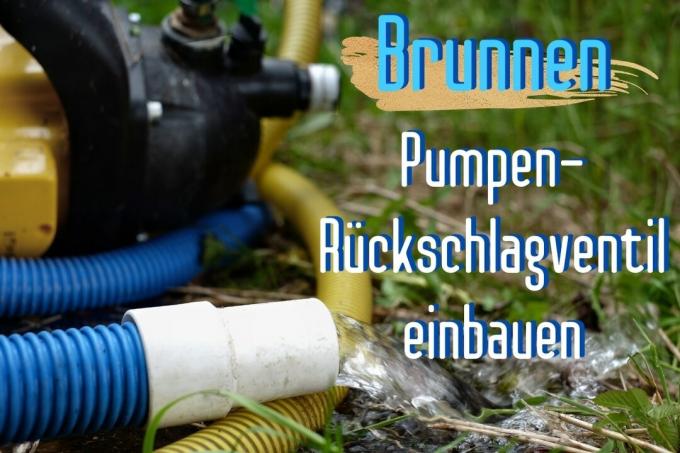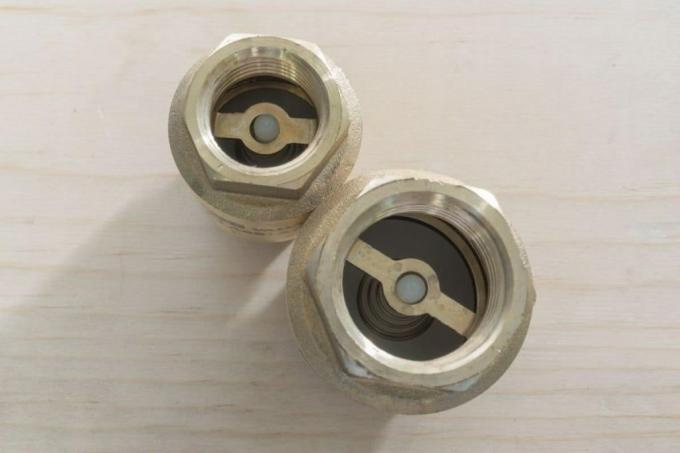
table of contents
- Utils
- preparation
- Install pump check valve: Instructions
- frequently asked Questions
A pump check valve ensures that the pumped water is no longer in the Fountain runs back. Not every pump is equipped with the valve, but it can be retrofitted.
In a nutshell
- Non-return valve can be retrofitted without any problems
- select correct valve size
- replace old with new valve
- Use sealant
Utils
Before you can start installing the pump check valve for your well, you will of course need the right pump check valve. This can be easily selected based on the diameter. The size is usually given in inches, which means that the right valve for your pump can be found quickly. Typical sizes are:
- 1/2 in
- 3/4 in
- 1 inch
- 1 1/4 in
- as well as 1 1/2 inches
- 2 inches

Larger or smaller valves are rare. The shape of check valves does not differ, which means that you can easily equip the pump for your well with them. In addition to the valve, you will also need the following aids to safely install the valve:
- Wrench (compatible with valve size) or pipe wrench
- Sealant: Teflon tape or hemp
Tip: In addition to the Teflon tape or hemp, you can also use a sealing paste such as Fermit. It optimizes the effectiveness of the seal.
preparation
Preparing to install the pump check valve for your well is important for the retrofit to be successful. The most important point is to turn off the power to the pump. Since you have to remove the hoses for installation, the risk of electric shock is too high if the device is still connected. Then dismantle the suction hose or the pipe that was mounted on the suction hole of the pump. You can then install the pump non-return valve.
Note: The best time to install the check valve is in spring or summer. In winter it is only worthwhile if you want to prepare the device for the next season.
Install pump check valve: Instructions
As soon as the preparation is complete, nothing stands in the way of installing the pump non-return valve for the well. The following instructions will help you install the valve:

- Spread sealant around the suction thread
- seal from top to bottom
- Apply sealing paste to sealant as required
- Do not use paste too thick
- Unscrew the pump check valve by hand
- Tighten well with a pipe wrench
- Check valve must be as tight as possible
- seal the next connecting pipe section
- screw on the non-return valve
- readjust
- Connect the pump and turn on the water
- Check valve for leaking water
- if in doubt, seal again
frequently asked Questions
The pump is protected from contamination with a suction filter. The water is pumped out of the upper part via the filter, which means that no sediments or other coarse substances are conveyed. For this reason, many check valves are already equipped with a suction filter today. They reduce pump wear and are effective against possible blockages.
Check valves made of brass, stainless steel, copper and plastic are offered. Because of the properties of each material, you don't have to worry about rust. The inexpensive plastic valves are completely sufficient for the garden. If you use the pump for pumping drinking water, metal valves are recommended because they are more robust in the long run.
You don't need to equip your well pump with a check valve if you already have one. Therefore, check in advance that the device has the valve. In this case, you can save yourself all the hassle of upgrading the pump. If you only use the device for gardening, no non-return valve is necessary.
The use of a check valve is problematic if the pump is not dismantled over the winter and stored frost-free. The function of the valve can freeze the water in the pipelines that are too far from the surface of the earth. This in turn poses a high risk of damage. If the pump is to be used over the winter, valves with automatic drainage are required.
